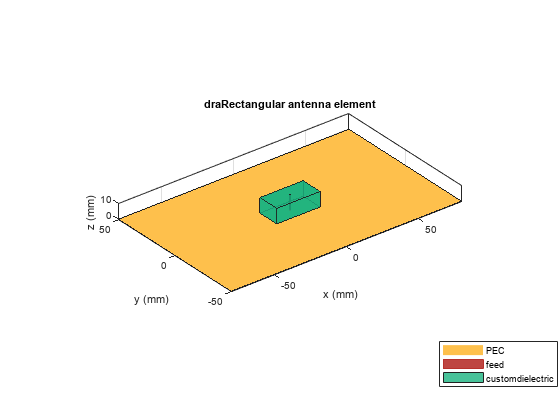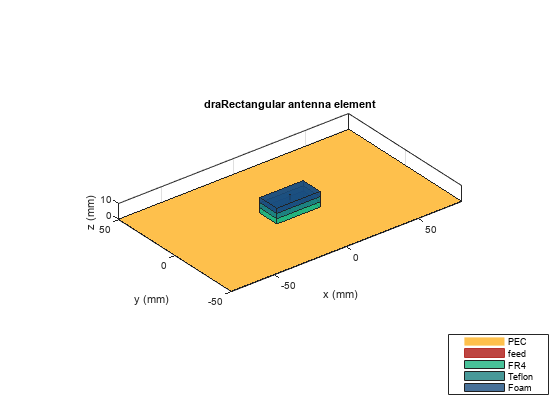draRectangular
Description
The default draRectangular object creates a rectangular dielectric
resonator antenna resonating around 5 GHz. The rectangular dielectric resonator antenna
consists of a rectangular-shaped dielectric placed on a ground plane. It has high
power-handling capacity and can provide high gain and bandwidth. The rectangular dielectric
resonator antenna has the advantage of two aspect ratio that aids in the generation of various
modes. These antennas are more suitable for use at microwave frequencies. Rectangular
dielectric resonator antennas are widely used in satellite and radar systems.
Creation
Description
dr = draRectangular
dr = draRectangular(PropertyName=Value)PropertyName is the property
name and Value is the corresponding value. You can specify several
name-value arguments in any order as
PropertyName1=Value1,...,PropertyNameN=ValueN. Properties that you
do not specify, retain their default values.
For example, dr = draRectangular(ResonatorLength=0.04) creates a
rectangular dielectric resonator antenna with the length of the dielectric resonator set
to 40 mm. and default values for other properties.
Properties
Object Functions
axialRatio | Calculate and plot axial ratio of antenna or array |
bandwidth | Calculate and plot absolute bandwidth of antenna or array |
beamwidth | Beamwidth of antenna |
charge | Charge distribution on antenna or array surface |
current | Current distribution on antenna or array surface |
design | Create antenna, array, or AI-based antenna resonating at specified frequency |
efficiency | Calculate and plot radiation efficiency of antenna or array |
EHfields | Electric and magnetic fields of antennas or embedded electric and magnetic fields of antenna element in arrays |
feedCurrent | Calculate current at feed for antenna or array |
impedance | Calculate and plot input impedance of antenna or scan impedance of array |
info | Display information about antenna, array, or platform |
memoryEstimate | Estimate memory required to solve antenna or array mesh |
mesh | Generate and view mesh for antennas, arrays, and custom shapes |
meshconfig | Change meshing mode of antenna, array, custom antenna, custom array, or custom geometry |
msiwrite | Write antenna or array analysis data to MSI planet file |
optimize | Optimize antenna and array catalog elements using SADEA or TR-SADEA algorithm |
pattern | Plot radiation pattern of antenna, array, or embedded element of array |
patternAzimuth | Azimuth plane radiation pattern of antenna or array |
patternElevation | Elevation plane radiation pattern of antenna or array |
peakRadiation | Calculate and mark maximum radiation points of antenna or array on radiation pattern |
rcs | Calculate and plot monostatic and bistatic radar cross section (RCS) of platform, antenna, or array |
resonantFrequency | Calculate and plot resonant frequency of antenna |
returnLoss | Calculate and plot return loss of antenna or scan return loss of array |
show | Display antenna, array structures, shapes, or platform |
sparameters | Calculate S-parameters for antenna or array |
stlwrite | Write mesh information to STL file |
vswr | Calculate and plot voltage standing wave ratio (VSWR) of antenna or array element |
Examples
More About
References
[1] McAllister, M.W., S.A. Long, and G.L. Conway. “Rectangular Dielectric Resonator Antenna.” Electronics Letters 19, no. 6 (1983): 218.
Version History
Introduced in R2021a



